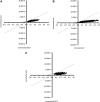A pilot cost-effectiveness analysis of treatments in newly diagnosed high-grade gliomas: the example of 5-aminolevulinic Acid compared with white-light surgery
- PMID: 25714513
- PMCID: PMC4410964
- DOI: 10.1227/NEU.0000000000000673
A pilot cost-effectiveness analysis of treatments in newly diagnosed high-grade gliomas: the example of 5-aminolevulinic Acid compared with white-light surgery
Abstract
Background: High-grade gliomas are aggressive, incurable tumors characterized by extensive diffuse invasion of the normal brain parenchyma. Novel therapies at best prolong survival; their costs are formidable and benefit is marginal. Economic restrictions thus require knowledge of the cost-effectiveness of treatments. Here, we show the cost-effectiveness of enhanced resections in malignant glioma surgery using a well-characterized tool for intraoperative tumor visualization, 5-aminolevulinic acid (5-ALA).
Objective: To evaluate the cost-effectiveness of 5-ALA fluorescence-guided neurosurgery compared with white-light surgery in adult patients with newly diagnosed high-grade glioma, adopting the perspective of the Portuguese National Health Service.
Methods: We used a Markov model (cohort simulation). Transition probabilities were estimated with the use of data from 1 randomized clinical trial and 1 noninterventional prospective study. Utility values and resource use were obtained from published literature and expert opinion. Unit costs were taken from official Portuguese reimbursement lists (2012 values). The health outcomes considered were quality-adjusted life-years, life-years, and progression-free life-years. Extensive 1-way and probabilistic sensitivity analyses were performed.
Results: The incremental cost-effectiveness ratios are below &OV0556;10 000 in all evaluated outcomes, being around &OV0556;9100 per quality-adjusted life-year gained, &OV0556;6700 per life-year gained, and &OV0556;8800 per progression-free life-year gained. The probability of 5-ALA fluorescence-guided surgery cost-effectiveness at a threshold of &OV0556;20000 is 96.0% for quality-adjusted life-year, 99.6% for life-year, and 98.8% for progression-free life-year.
Conclusion: 5-ALA fluorescence-guided surgery appears to be cost-effective in newly diagnosed high-grade gliomas compared with white-light surgery. This example demonstrates cost-effectiveness analyses for malignant glioma surgery to be feasible on the basis of existing data.
Figures




References
-
- Merrell RT, Wen PY. Management of Gliomas 2010. Available at: http://www.clinicaloptions.com/inPractice/Oncology/Brain_and_CNS_Maligna.... Accessed September 18, 2011.
-
- Crocetti E, Trama A, Stiller C, et al. Epidemiology of glial and non-glial brain tumors in Europe. Eur J Cancer. 2012;48(10):1532-1542. - PubMed
-
- Curran WJ, Jr, Scott CB, Horton J, et al. Recursive partitioning analysis of prognostic factors in three Radiation Therapy Oncology Group malignant glioma trials. J Natl Cancer Inst. 1993;85(9):704-710. - PubMed
-
- Stupp R, Mason WP, van den Bent MJ, et al. Radiotherapy plus concomitant and adjuvant temozolomide for glioblastoma. N Engl J Med. 2005;352(10):987-996. - PubMed
Publication types
MeSH terms
Substances
LinkOut - more resources
Full Text Sources
Medical

